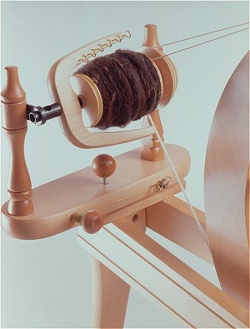Spinning Frequently Asked Questions
Q Should I go for a single or double drive and what is the difference?

A wheel set up for double-drive will have a single drive-band wrapped once around the flyer, back round the wheel and then around the bobbin. (It needs to be crossed over for this to happen). The grooves in the flyer and bobbin are different sizes, so like the gears on a bike, the two things will turn at different speeds. The lack of a brake or tension mechanism makes for free and easy treadling.
Genius! Well, not quite.
Sometimes, different types of grooves in the bobbin and flyer (U and V) can mean that one is driven more positively and the other is allowed to slip, this slippage is important, but relies on the tension and drive band material being right. Furthermore, your ratio and take-up will change depending on whether the bobbin is full or empty. You can adjust the take-up by adjusting the drive band tension, there's a smaller degree of adjustment than with single-drive.
The scotch tension / single-drive probably suits less experienced spinners as it gives you more control. Only the flyer (scotch) or the bobbin (irish) is driven. An adjustable 'brake' is applied to the bobbin in order to slow it down. This gives you a wider degree of control. If you let it, the yarn will wind onto the bobbin very quickly; if you grip your fibre more tightly, you'll be able to hold it back and get lots of twist. adjusting the brake tension gives you a very wide degree of control over how hard the yarn pulls in.
Some wheels are made to work just in single or just in double drive mode. Ashford double-drive wheels allow you to switch between single- and double-drive modes.
